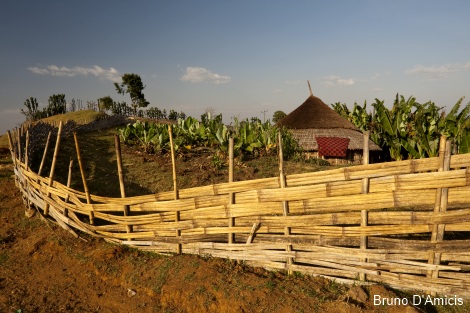EXPLORE » HISTORY & CULTURE » TRADITIONS
TRADITIONS
COFFEE CEREMONY
An invitation to a coffee ceremony denotes friendship and respect. A woman begins the ceremony in a corner of the house by scattering fresh cut grass which provides a fresh scent. She seats herself on a stool before a charcoal brazier. Incense burns to enhance the atmosphere. She roasts the coffee beans in a pan over the coals shaking them in order to roast them evenly. As they roast, guests draw the aromatic smoke toward themselves breathing deeply as a polite gesture. Next, the woman grounds the roasted beans with a mortar and pestle. The pestle's pounding noise serves as an invitation for everyone to join the coffee ceremony. The coffee is then brewed in a traditional ceramic coffee pot or a natural bamboo cup. She serves the coffee in a small cup with three spoonfuls of sugar. Traditional ensete, or false banana (Ensete ventricosum), bread is often served with the coffee. When the first pot is finished the woman will often brew another pot. Tradition allows for three rounds of coffee to be brewed with the same grounds. This ceremony signifies solidarity in the community which is especially important in times of food shortage.

MEALTIME RITUALS
“Those who eat from the same plate will not betray each other.” - Ethiopian Proverb
During a traditional Ethiopian meal, one does not eat alone or from a separate plate. Ethiopians do not use utensils to eat but rather Injera, a filling pancake-like bread, to scoop up their food. The highest quality Injera consists of tef, an endemic Ethiopian grass. The ritual of breaking the Injera signifies friendship and loyalty. When eating, Ethiopians use their right hand to feed either themselves or another person at the table. Feeding a morsel into someone else’s mouth is called Gursha and denotes a gesture of affection. Commonly, the host will feed guests the tastiest morsels as an expression of honour and hospitality.
DOMESTIC LIFE
In the rural landscape of Kafa, most of the houses consist of local materials, such as wood, and a reinforcement of sticks and clay. The thatched grass roofs normally need to be replaced every three to four years. These tukul huts, as they are called, are circular with a conical roof and earthen floor. The tukul and its surrounding garden fit perfectly into the landscape, a design which has developed over centuries. Traditional rural households are built in harmony with nature. The garden, naturally fertilized by domestic animals, includes ensete trees, coffee plants and vegetables, a woven goto cylinder stores cereals throughout the year, and a living fence made from bamboo or flowering bushes frames the domestic living area. In the urban areas of Kafa people live in traditional tukuls and also in houses made of natural materials with tin roofs. The size of homes varies according to the wealth and social status of the family.

GUDDO
A Guddo is a holy stone or shrine located in a small patch of forest. The Guddo represents a belief system in Kafa based on spirits which can cure people of illness or punish them for wrongdoings. A few times a year the people of Kafa hold a worshipping to honour the spirits, ensure good harvests, ward off evil spirits, and promote well-being. Every clan has its own Guddo where they slaughter oxen and feed the blood to the spirit which resides under the stone. The clans believe that the spirit will move away if anyone other than a Manja first approaches the Guddo. Therefore, the Manja responsibly clear the forest around the stone in preparation for the worship services.
ETHIOPIAN TIMEKEEPING
Ethiopia uses a calendar based on the old Egyptian calendar. Twelve months each consisting of 30 days and a thirteenth month with five days, or six during a leap year, structures the Ethiopian calendar. Their calendar is seven years and eight months behind the widely-used Gregorian calendar with the New Year starting in September. Ethiopians celebrated the millennium on September 12, 2007. Ethiopians' clock consists of a twelve hour day beginning at sunrise, which is 6:00 Greenwich Mean Time (GMT), and a twelve hour night starting at sundown or 18:00 GMT. Therefore when it is 7:00 Ethiopian time it is 13:00 GMT.
RELIGIOUS CELEBRATIONS
Ethiopian Orthodox Christians constitute the majority of the population in Ethiopia as well as in Kafa. The country celebrates holidays with elaborate ceremonies. These striking ceremonies bring history and culture alive with spirited customs that have not changed in 1000 years. Christians celebrate the New Year on September 11. Meskel, or Finding the Cross, takes place on September 17 and includes dancing, feasting, and lighting a bonfire. Ledet, Christmas, is a big celebration on January 7 with a colourful procession, mass, and feast. Timket, one of the grander celebrations, is Ethiopia’s Epiphany which Christians celebrate on January 11 with a colourful processions and slaughtering of sheep or goat. Eid-al-Fitr is the Muslim festival which celebrates the end of the fasting month of Ramadan, the ninth month in the Islamic calendar, which normally falls in September or October. The Festival of Sacrifice, Eid-al-Adha, is a Muslim festival which celebrates family, friends, and thanksgiving. This holiday occurs 70 days after the end of Ramadan.
